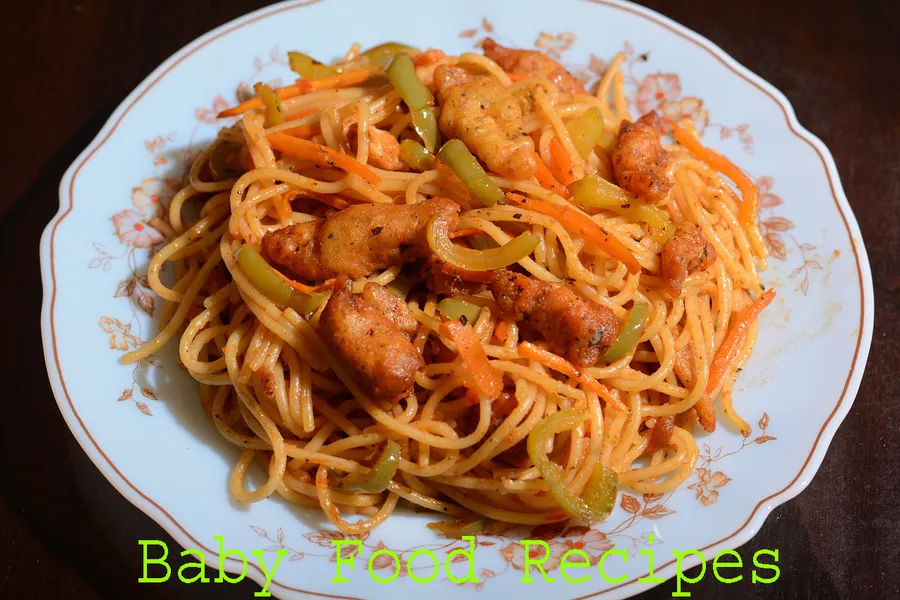Feeding your baby is an exciting journey.Babies begin to experiment with different flavors and textures between the ages of 6 and 8 months.
This is a crucial stage for their growth and development. Creating simple and nutritious meals can be fun and rewarding. Your baby will begin to enjoy a variety of flavors, from fruits to vegetables. At this age, they can handle purees and soft foods.
You want to ensure their diet is healthy and balanced. Homemade baby food recipes are a great way to control ingredients. They also allow you to introduce new flavors without additives. In this blog post, we will share easy baby food recipes perfect for 6 to 8 months old. These recipes will help you nourish your little one while making mealtime enjoyable.
What is Feeding Babies
Feeding babies is an important step. At 6-8 months, many babies are ready for solid food. Look for signs that show readiness.
Signs Your Baby is Ready:
- Your baby can sit up with support.
- They show interest in food.
- Your baby can move food to their mouth.
- They can swallow without pushing food out.
Watch for these signs. They mean your baby is ready to try new flavors and textures. Start with simple foods like mashed fruits and vegetables. One food at a time should be introduced.This helps to check for allergies.
Nutritional Needs For 6-8 Month Olds
Babies aged 6-8 months need a balanced diet. They require important vitamins and minerals for growth. Key nutrients include:

- Iron: Helps with healthy blood.
- Calcium: Supports strong bones and teeth.
- Vitamin C: Boosts the immune system.
- Vitamin A: Aids vision and skin health.
Also, babies need the right mix of macronutrients. This includes:
- Proteins: For muscle growth.
- Fats: For brain development.
- Carbohydrates: For energy.
Focus on pureed foods. They are easy to digest. Offer a variety of flavors and textures.
Getting Started With Purees
Starting with purees is fun and easy. Simple fruit purees are a great choice. Use fruits like bananas, apples, and pears. Just mash or blend them until smooth. Add a little water if needed. This makes the puree easier to eat.
For vegetable purees, try carrots, sweet potatoes, or peas. Steam the veggies until soft. Then blend them until smooth. You can add water or breast milk for creaminess. Make sure there are no lumps. Lumps can be hard for babies to swallow.
Keep the flavors simple. This helps babies enjoy new tastes. Start with one fruit or vegetable at a time. Watch for any allergies or reactions. Enjoy this fun time of feeding!
First Proteins For Babies
Chicken and turkey are great first proteins for babies. They are rich in iron and protein. Start with small amounts to check for allergies. Cook the meat well. Use a steamer or boil it until soft.
After cooking, blend the meat with water or broth. This makes a smooth puree. You can also mix in vegetables for flavor. Try carrots or peas for extra nutrients.
Fish is another good option. Choose low-mercury fish like salmon or cod.After the fish is cooked through, remove all of the bones. Blend with water to create a smooth texture.
Always introduce new foods one at a time. Wait three days before adding another. This helps spot any allergic reactions.
Grain And Cereal Options
Rice cereal is simple to make. To begin, combine one cup of rice with two cups of water. Cook the rice until soft. Blend with water for a smooth texture. Add breast milk or formula for creaminess.
Oatmeal is another great option. Use instant oats or rolled oats. Cook them with water or milk. Blend for a smooth finish. Try adding mashed bananas or pureed apples for flavor.
Both cereals can be made in batches.Keep in the refrigerator for up to three days. Warm before serving.
Always take your baby’s temperature before feeding them.
Combining Flavors
Combining fruits and vegetables makes tasty baby food. Use sweet fruits like banana or apple. Pair these with mild veggies like carrot or sweet potato. This mix gives nutrients and flavor.
Here are some easy combos:
- Banana and carrot
- Apple and sweet potato
- Peas and pear
- Avocado and banana
These purees are smooth and easy to eat. They help babies try new tastes. Making them at home is simple. Just steam or bake the veggies. Then blend with the fruits. Add a little water if needed.
Finger Foods Introduction
Introducing finger foods is exciting for babies. They can explore new textures. Safe finger foods are important for their health.
Here are some safe options:
- Soft cooked vegetables like carrots or peas.
- Small pieces of banana or avocado.
- Cheerios or other o-shaped cereals.
- Small bits of tofu or cooked chicken.
Encouraging self-feeding helps babies learn. They develop fine motor skills. Let them try eating on their own. This can be messy but fun!
Always watch your baby while they eat. Ensure they are safe and happy. Make mealtime a joyful experience.
Allergy Awareness And Food Sensitivities
Food allergies can be serious. Many babies have reactions to certain foods. It’s important to know common allergens.
| Common Allergens | Why Avoid |
| Milk | Can cause skin rashes and stomach issues. |
| Eggs | May lead to breathing problems or hives. |
| Peanuts | Can cause serious allergic reactions. |
| Soy | May cause digestive problems. |
| Wheat | Can lead to stomach pain and rashes. |
Always watch for any signs of an allergic reaction. Look for hives, swelling, or trouble breathing. These can happen right after eating.
Note the time between feeding and any reaction. Keep track of what your baby eats. This helps doctors if there is a problem.
Hydration For Your Baby
Keeping your baby hydrated is very important. Particularly when they begin eating solid foods, babies require water. At 6-8 months, babies can drink small amounts of water. Offer water in a sippy cup to help them learn. Aim for about 2-4 ounces of water each day.
Avoid giving your baby juices or sweetened drinks. These drinks can harm their teeth. They may also fill your baby up, making them eat less healthy food. Stick to plain water for the best hydration.
| Age | Water Intake |
| 6-8 Months | 2-4 Ounces |
Storing And Preparing Baby Food
Storing baby food properly is very important. Use clean containers. Glass jars or BPA-free plastic work well. Label each jar with the date. This helps track freshness.
Frozen baby food lasts longer. Freeze in small portions. Ice cube trays are great for this. Once frozen, transfer cubes to a ziplock bag.
For meal prep, cook in batches. Make different flavors at once. This saves time and effort. Always cool food before storing it.
Check for any signs of spoilage. Discard food that looks or smells bad. Keep baby food in the fridge for up to 48 hours.
Using these tips makes feeding time easy and safe.
Adapting Family Meals For Babies
Making baby-friendly meals is easy. Start with simple ingredients. Use fruits and vegetables. Cook them until soft. Mash them well. This helps babies eat safely.
For family dinners, adjust the recipe. Avoid strong spices. Keep flavors mild. Offer small portions. Cut food into tiny pieces. Always check for choking hazards.
Try these ideas:
- Mashed bananas: Soft and sweet.
- Steamed carrots: Sweet and smooth.
- Oatmeal: Easy to digest.
Incorporate your baby into meals. Share family time. This helps babies learn eating habits. It builds connections too.
Frequently Asked Questions
What Are Easy Baby Food Recipes For 6-8 Months?
Easy baby food recipes for 6-8 months include pureed fruits and vegetables. Consider mashed bananas, sweet potatoes, or applesauce. These recipes are simple and nutritious. Always introduce new foods gradually to monitor for allergies. Homemade baby food is fresher and free from preservatives.

Can I Use Store-bought Baby Food?
Yes, store-bought baby food is convenient and safe. Look for organic options without added sugars or preservatives. Always check the label for age-appropriate foods. Store-bought baby food can be a great supplement to homemade meals. Ensure to choose varieties that match your baby’s dietary needs.
How Do I Introduce Solids To My Baby?
Start by offering single-ingredient purees. Choose mild flavors like carrots or peas. A new cuisine should be introduced every three to five days. This helps to identify any food allergies. Always watch for signs of readiness, such as sitting up and showing interest in food.
What Fruits Are Best For Baby Food?
Great fruits for baby food include bananas, apples, and pears. They are easy to digest, nourishing, and soft. You can also try avocados for healthy fats. Always ensure fruits are ripe and well-pureed. This makes them safe and enjoyable for your baby.
Final Thoughts
Creating baby food for your little one is rewarding. Simple recipes help introduce new flavors and textures. Remember to keep meals healthy and balanced. Fresh fruits and vegetables are great choices. Before sampling new meals, always make sure you don’t have any allergies. Enjoy this special time with your baby.
Cooking together can be fun and educational. Your baby will love exploring food. Healthy eating habits start early. Happy cooking and feeding!

